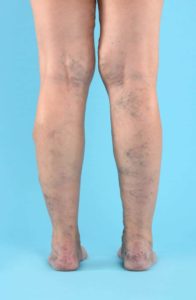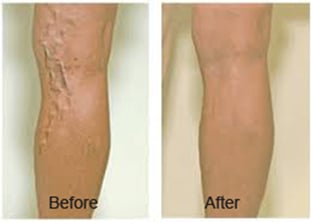Varicose Veins Affect More Than 20 Million Americans
When most people hear the words vascular surgeon they think of a very common affliction called varicose veins. Affecting more than 20 million Americans, varicose veins represent one form of chronic venous insufficiency over an entire spectrum of venous disease. This video explores in more detail what is meant by the term chronic venous insufficiency.
Dr. Zakhary has extensive experience in treating painful, inflamed varicose veins. Our office specializes in radiofrequency ablation which is done in the office in about an hour. This and other vein treatments can be very effective in relieving symptoms when other conservative types of treatments have failed to do so. This treatment is typically covered by most insurance plans. Please call our office today to find out more.
What Are Varicose Veins?
While our arteries are tasked with distributing oxygenated blood throughout the body, our veins have the job of returning the deoxygenated blood back to the heart. In the legs, this means having to fight gravity the entire way. Prolonged standing, as for some occupations, also increases the pressure on our legs and feet.
If the vein walls weaken, blood can push them outward and it can pool. This enlarges the veins and makes them more serpentine than when blood flow is efficient. If this pooling occurs near the surface skin, the vein can push up the skin giving the appearance of a raised path not unlike a mole tunnel on a Scottsdale golf course. This is a varicose vein.
In most cases, varicose veins are simply a cosmetic issue, making a person avoid wearing shorts or bathing suits to keep their varicose veins covered. Other people have painful varicose veins, and sometimes these can lead to more serious health issues.
How Do Varicose Veins Develop?

Blow flow returning to the heart is a tough climb out of the feet and up through the legs. Our muscles and the support tissues that surround our veins usually help push the blood upward by squeezing the veins slightly as we move our legs and feet. But as we age, these tissues weaken and don’t provide the same degree of support.
And the veins weaken, as well. Their walls become less rigid, and this allows the blood to push outward in spots, making the veins form a more meandering path. The valves that prevent backflow in the veins can also begin to fail or at least leak. This allows blood to pool in spots. This widens the veins.
All of this leads to the purple, often raised, curves of varicose veins. These are purple because they are carrying deoxygenated blood.
What Are the Symptoms of Varicose Veins?

Most varicose veins are quite visible on the surface of the legs. They cause the skin to bulge upward with their twisting pattern. They show as purple or dark blue cords on the legs. Some varicose veins are entirely painless for the person, but others can cause continual aching and pain. For varicose veins that cause pain, there are the symptoms to look for:
- Achy or heavy feeling in the legs
- Increased pain after sitting or standing for a long period
- Burning, throbbing, muscle cramping, and swelling in the legs
- Bleeding varicose veins
- Itching around a vein
- A raised, cordlike appearance that pushes the skin outward
- Hardening of the vein, color changes, skin ulceration near the ankle, which is a sign of a serious form of vascular disease
What Are the Main Causes of Varicose Veins?
The passage of time and pregnancy are the two main causes of varicose veins.
- Aging — As we age, our vein walls lose some of their elasticity. This not only allows them to stretch, but it also means they won’t move the blood as effectively. The muscles that help push the blood are weakened, as well.
- Pregnancy — Some women develop varicose veins in pregnancy. This is because pregnancy increases the volume of blood in the body but decreases the flow of blood from the legs to the pelvis. While this is good for the developing fetus, it’s bad for the appearance of the legs when varicose veins form. Varicose veins in pregnant women usually improve on their own from 3-12 months after delivery
There are a few risk factors that make it more likely you’ll develop varicose veins:
- Sex — Women are more likely to develop varicose veins due to hormonal changes during pregnancy, pre-menstruation, or menopause.
- Family history — There is a genetic factor in the development of varicose veins.
- Obesity — The added weight of obesity places more pressure on the veins in the legs and feet.
- Occupations — Jobs that require prolonged standing or sitting inhibit blood flow in the legs and feet, enabling varicose vein development.
How are varicose veins treated?
As mentioned above, the first treatment options for Dr. Zakhary are conservative treatments and adjustments in the patient’s lifestyle. If these are unsuccessful, the veins in question will need to be closed off to eliminate them. Once an unhealthy vein is closed off, the body instantly re-routes the blood to an adjacent healthy vein, and the body then breaks down and absorbs the closed off unused vein.
These are the treatment methods Dr. Zakhary may employ. He specializes in radiofrequency ablation, in particular.
- Radiofrequency ablation — In this minimally invasive procedure, Dr. Zakhary inserts a catheter into the varicose vein. The catheter has a thin fiber that delivers radiofrequency energy into the vein. When delivered, the RF energy instantly converts to heat, and this damages the vein walls, causing them to collapse. This closes off the vein. The RF fiber is then pulled back to the next section of the vein and the process is repeated until the length of the vein has been closed off.
- Sclerotherapy — Smaller varicose veins may be treated with sclerotherapy. The vein is injected with a sclerosant solution. This solution irritates the vein wall, causing the wall to collapse, closing off the vein. Sometimes veins may need more than one treatment.
- Foam sclerotherapy — In foam sclerotherapy, gas is mixed with the sclerosant agent. The bubbles in the foam push the blood out of the way, making the sclerosant solution more efficient in reacting with the vein wall.
- Laser treatment — Lasers can be used on smaller varicose veins. The laser is set to the wavelength of the color of the vein. The laser energy is then directed onto the vein and the vein absorbs the energy. This instantly converts to heat and damages the vein wall, closing it off.
- Vein stripping or ligation — Prior to catheters and laser options, ligation was the only treatment for large varicose veins. This is a surgical procedure where the vein is tied off and then removed in pieces through small incisions.
- Endoscopic vein surgery — In cases with advanced leg ulcers, endoscopic vein surgery may be necessary. A tiny video camera is inserted into the leg to provide visual guidance, and then the varicose veins are closed and removed.
Will compression stockings solve my varicose vein problem?
When Dr. Zakhary is helping a patient deal with his or her varicose veins, often the first treatment is to begin wearing compression stockings. They are worn all day and they provide outward pressure on the legs, steadily squeezing the legs. This gives the veins the support they are lacking. Compression stockings, along with some of the above measures such as losing weight, might be all you need. But in other cases, Dr. Zakhary needs to move on to other treatment options.
Varicose Vein Treatment Before & After

What happens after my treatment?
As mentioned above, Dr. Zakhary specializes in radiofrequency ablation of varicose veins. When your treatment is over, we’ll put you in a pair of compression stockings. These hose help ensure the vein stays closed and jumpstarts the process of the body eventually absorbing the now-unused vein. You’ll wear your stockings overnight for the first night. After that, you’ll wear them during the day for at least two weeks.
Before you leave our Glendale offices, you’ll be directed to take a 20-30-minute walk. Then you can drive home. From there, walking at least 30 minutes each day is mandatory.
You can return to normal activities immediately but should avoid standing still for long periods, and you’ll need to avoid long-haul flights for at least 3-4 weeks.
Dr. Zakhary will have you return for an ultrasound check of your treated veins two weeks after your treatment.
Is there anything I can do to prevent varicose veins from forming?
There isn’t anything you can do to completely prevent the formation of varicose veins, but if you improve your muscle tone and your circulation, this reduces the possibility. The following measures can help lessen any pain you may have from a varicose vein, and it also helps to prevent future veins from developing:
- Get exercise to improve circulation
- Manage your weight
- Eat a high fiber diet
- Lower your salt intake
- Elevate your legs when sitting or watching TV
- Avoid high heels and overly tight hosiery
- Change positions frequently when sitting or standing
Is there any risk with radiofrequency ablation for varicose veins?
Complications are very rare with RF ablation. There is a possibility of deep vein thrombosis/clotting. Nerve damage to surface sensory veins is possible, but these nerves usually return to normal in a few weeks to months.
Patient Testimonials:
"As always before, the staff at Dr. Zakhary's office were, professional, friendly, and helpful! I have been a patient of Dr. Zakhary's for about four years, and I have never had any complaints! I would highly recommend Dr. Zakhary to anyone who needs vascular care, or wound care!"
"This office has an amazing staff and Dr. Zachary is one of the best doctors I’ve ever seen! He’s great at his profession, he’s very personable, and funny"
"The staff with Sammy A. Zakhary is top notch. Very warm and friendly and accommodating. You are in good hands here."
"Dr. Zakhary is very thorough. He cares for his patients, takes time too listen and plan the next best step for care. Highly recommend him!"
Schedule a Consultation Today
If you're interested in learning more about varicose veins please contact us for a consultation at (623) 258-3255 or fill out our contact us form below. We will discuss your needs and concerns, and determine your best course of action.
